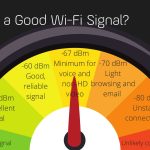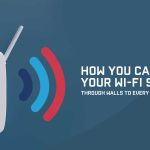A signal strength of around -50 dBm to -70 dBm is generally considered good. At these levels, your device should experience fast and stable internet, making streaming, gaming, and browsing smooth. Anything above -50 dBm provides excellent signal quality, while weaker signals below -70 dBm might lead to slower speeds and interruptions.
In simple terms, if your signal strength is between -50 dBm and -70 dBm, you’re in a good spot for reliable connectivity. Signals weaker than -70 dBm can still work but might struggle with consistency, and anything weaker than -90 dBm usually means a very poor connection. Understanding what dBm levels constitute good signals can help you troubleshoot or optimize your Wi-Fi or cellular connection for better performance.
When it comes to wireless signals, understanding what dBm levels are considered good can save you from frustrating connection issues. Whether you’re at home or on the go, knowing the right signal strength helps you get the most out of your internet connection. Through a quick glance at your device’s signal meter, you can gauge whether you’re in a strong zone or need to move closer to a router or cell tower. This simple knowledge empowers you to improve your online experience without needing technical expertise. Keep reading to learn exactly what dBm levels mean and how to achieve the best signal for your needs.
What dBm is good signal strength?
Understanding dBm and Signal Strength Basics
dBm stands for decibels relative to one milliwatt. It measures the power level of a wireless signal. The value of dBm helps us understand how strong or weak a signal is. The closer the dBm is to zero, the stronger the signal.
Wi-Fi and cellular signals are often expressed in dBm. Because dBm is a logarithmic measurement, small changes can mean big differences in signal quality. This makes understanding dBm crucial for troubleshooting connectivity issues.
What Does a Typical dBm Range Look Like?
In general, Wi-Fi signals range from about -30 dBm to -90 dBm. These values help identify whether your connection is strong or weak. Let’s look at the typical ranges and what they mean for your device.
| dBm Value | Signal Quality | Connection Type | Use Case |
|---|---|---|---|
| -30 to -50 | Excellent | Strong Wi-Fi signal | Streaming, gaming, video calls |
| -50 to -60 | Good | Reliable connection | Browsing, streaming |
| -60 to -70 | Fair | Moderate connection | Light browsing, occasional streaming |
| -70 to -80 | Poor | Weak signal | Possible disconnections, buffering |
| -80 to -90 | Very weak | Very unstable connection | Likely no connectivity |
Interpreting Signal Strength for Wi-Fi
For Wi-Fi, signals stronger than -50 dBm are ideal for most tasks. Between -50 and -60 dBm usually provides a good experience for streaming and gaming. If your signal drops below -70 dBm, you may experience interruption or slow speeds.
To improve weak Wi-Fi signals, consider repositioning your router, removing interference, or investing in a Wi-Fi extender. These adjustments can help boost your signal to a more desirable level.
Cellular Signal Strength and dBm
Cellular devices also measure signal strength in dBm. Typically, a good cellular signal is between -70 and -85 dBm. Values above -70 dBm indicate a very strong signal, which results in quicker data speeds and fewer call drops.
Conversely, signals weaker than -85 dBm can cause slow data, dropped calls, and poor voice quality. In rural areas or areas with many obstacles, signals tend to be weaker due to distance and interference.
How to Measure Your Signal Strength
You can check your device’s signal strength through settings or specific apps. Many smartphones display dBm levels in their network section. Wi-Fi analyzers provide detailed signal metrics and help locate the best spot for your router.
Using these tools, aim for the strongest signal possible, ideally between -50 and -60 dBm. Note that moving closer to your router or cell tower can significantly improve the dBm reading.
Factors Affecting Signal Strength
Multiple factors influence your signal levels, including physical obstructions, distance, interference, and device quality. Walls, furniture, and appliances can weaken Wi-Fi signals. Distance from the router or cell tower naturally reduces signal strength.
Electromagnetic interference from other electronic devices can also cause fluctuations in signal levels. Using higher quality equipment and reducing interference sources helps maintain better signal strengths.
Optimizing Your Signal for Better Performance
Placing your router in a central location without obstructions can enhance Wi-Fi signal strength. Keep devices away from metal objects or appliances that emit interference. Ensuring your device is within a reasonable distance from the router boosts dBm levels.
Upgrading to a dual-band or mesh Wi-Fi system can also improve coverage and signal quality across larger areas. For cellular signals, using signal boosters or relocating to higher ground can increase dBm levels.
Key Takeaways About Good Signal Strength in dBm
- Generally, a Wi-Fi signal stronger than -60 dBm is good for most activities.
- Cellular signals above -85 dBm are suitable for reliable calls and data use.
- Weak signals below -70 dBm can cause buffering, slow data, and dropped calls.
- Optimal placement and equipment upgrades improve signal quality.
- Regularly checking your dBm levels helps troubleshoot connection issues.
Related Topics: Improving Wireless Signal Strength
Using Wi-Fi Extenders and Mesh Networks
Wi-Fi extenders and mesh systems help cover larger areas with strong signals. They reduce dead zones and ensure consistent connectivity. Proper placement of these devices is essential for maximum benefit.
Reducing Interference
Minimize interference from other electronics and neighboring networks. Changing your Wi-Fi channel can offer a clearer signal path, improving dBm readings. Use apps to identify less congested channels.
Upgrading Equipment
Older routers and mobile devices may have weaker antennas or outdated technology, leading to lower dBm levels. Upgrading to newer, dual-band or tri-band models can significantly enhance signal strength and stability.
Conclusion
In essence, understanding what constitutes a good dBm signal strength helps in optimizing your wireless connections. Maintaining a signal above -60 dBm for Wi-Fi and -85 dBm for cellular generally provides a reliable experience. Regularly monitoring and improving your signal can prevent frustrating interruptions and ensure your device stays connected where you need it most.
12 – Understanding Signal Strength in mW and dBm
Frequently Asked Questions
What signals are considered acceptable for reliable internet connectivity?
Signals with a strength around -60 dBm to -70 dBm usually provide reliable internet performance for most applications. At this range, your device maintains a strong connection, supporting smooth browsing, streaming, and downloads. Anything weaker than -70 dBm may lead to slower speeds or intermittent connectivity, while stronger signals, closer to -30 dBm, indicate an excellent connection quality.
How does signal strength impact Wi-Fi performance at home?
A good Wi-Fi signal strength ensures steady data transfer rates and reduces lag during online activities. When the signal is between -50 dBm and -60 dBm, you typically experience minimal buffering and quick response times. As the signal weakens beyond -70 dBm, you might notice lagging videos, dropped calls, or difficulty connecting to the network. Maintaining a strong signal close to -50 dBm improves overall user experience.
What are the telltale signs of a weak signal in my network?
If your device frequently disconnects, takes longer to load pages, or encounters slow download speeds, your signal might be weak. Signals weaker than -70 dBm often cause these issues, especially in large or obstructed spaces. Moving closer to your router or removing physical barriers can help strengthen the connection and improve performance.
Final Thoughts
A good signal strength typically ranges from -50 dBm to -70 dBm. Within this range, your connection remains stable and fast enough for most activities. Signals weaker than -70 dBm can cause interruptions and slower speeds.
What dBm is good signal strength? Generally, anything above -70 dBm is considered acceptable for reliable use. Understanding these levels helps you optimize your device placement for better connectivity.




